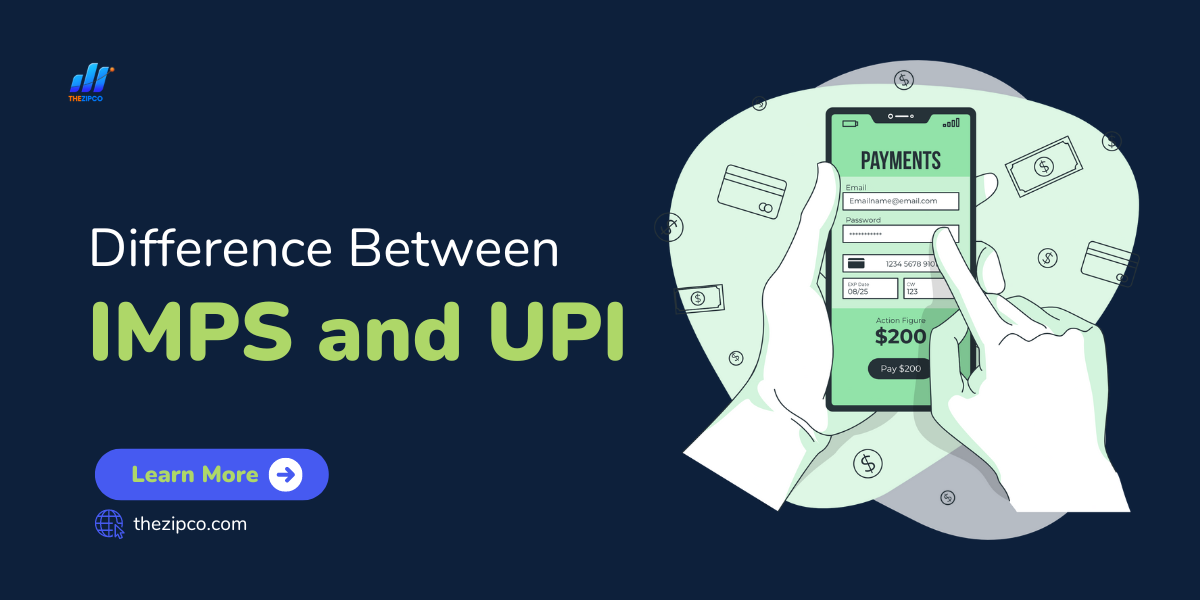The digital revolution in India has transformed financial transactions. Among the top digital payment methods, IMPS and UPI are prominent for their fast and secure money transfers.
Both services provide instant money transfers, yet each has its own unique features.
This blog delves into the key differences between IMPS and UPI, helping you determine which payment method best suits your needs.

What is IMPS
Immediate Payment Service (IMPS) is an instant payment system created by the National Payments Corporation of India Limited (NPCIL), enabling real-time interbank fund transfers. Available 24/7, including weekends and holidays, it allows users to send and receive money instantly across India.
Key Features of IMPS
Availability: IMPS is accessible via multiple channels, including mobile banking, internet banking, ATMs, and bank branches.
Transaction Limit: The daily transaction limit for IMPS is generally set at ₹5 lakh.
Fees and Charges: IMPS transactions usually come with a small fee ranging from ₹5 to ₹15, depending on the bank and transaction amount.
Security: IMPS employs secure protocols and requires details like the recipient’s account number and IFSC code for fund transfers.
What is UPI
The Unified Payments Interface (UPI) is a payment system that allows users to connect multiple bank accounts to a single mobile app and make instant fund transfers using a Virtual Payment Address (VPA) or mobile number.
UPI, developed by the NPCIL, has gained widespread popularity for its ease of use and versatility.
Interoperability: UPI lets users connect multiple bank accounts to a single app, making fund management simpler.
Virtual Payment Address (VPA): UPI replaces account numbers and IFSC codes with a VPA (e.g., yourname@bank), making transactions easier to remember.
No Transaction Fees: Typically, UPI transactions are free for users, though some banks may impose small fees for specific transactions.
Instant Transfers and Payment Requests: UPI supports both immediate fund transfers and the ability to request payments from others.
Wide Acceptance: UPI is broadly accepted for various payments, including online shopping, bill payments, and peer-to-peer transfers.
Key Difference Between IMPS and UPI
Although both IMPS and UPI are intended for immediate fund transfers, they vary in terms of user experience, transaction fees, security features, and overall convenience.
Below are the major differences between the two payment systems:
| Factors | IMPS | UPI |
| Transaction Process | Transfers via IMPS require the recipient’s bank account number and IFSC code, making the process a bit more complex compared to UPI. | UPI simplifies transfers by allowing users to send money using a VPA, mobile number, or QR code, making it more user-friendly. |
| User Experience and Interface | IMPS is accessed mainly through banking apps, mobile banking, internet banking, and ATMs, with the interface varying by bank. | UPI apps like Google Pay, PhonePe, and Paytm provide a seamless experience with features like contactless payments and bill splitting. |
| Speed of Transactions | Both IMPS and UPI offer instant transfers, but IMPS may occasionally face delays due to server or traffic issues. | UPI transactions are also instant, but the system is optimized for high-speed, low-latency transactions, reducing delays during peak times. |
| Transaction Limits | IMPS limits depend on the bank, typically ranging from ₹1 lakh to ₹5 lakh daily. Corporate accounts might have higher limits. | UPI typically has a daily limit of ₹1 lakh, though this may vary. Some banks offer higher limits upon request, but it usually remains lower than IMPS for large transactions. |
| Fees and Charges | IMPS transactions come with nominal fees, typically ranging from ₹2.5 to ₹25 per transaction, depending on the bank’s policies. | UPI transactions are generally free, though some banks may charge a small fee for specific transactions, which is usually less than IMPS fees. |
| Security and Privacy | IMPS requires sharing sensitive bank details like the account number and IFSC code, which may raise privacy concerns. | UPI uses a VPA or mobile number, avoiding the need to share sensitive bank details. UPI apps also use advanced encryption and two-factor authentication (2FA). |
| Accessibility and Use Cases | IMPS can be accessed through various channels, making it suitable for transferring funds between accounts with detailed information. | UPI is mainly used via mobile apps, ideal for peer-to-peer payments, merchant transactions, and online payments, with added flexibility for bill payments and QR code transactions. |
| Wide Range of Features | IMPS is primarily focused on fund transfers and offers basic functionality. | UPI provides a wide range of features, including bill payments, money requests, QR code scanning, and split payments, making it more versatile. |
Which is Better: IMPS or UPI
Choosing between UPI and IMPS depends on your specific needs and preferences. Consider these factors to make a well-informed decision:
IMPS: Offers convenience with faster transfers due to the lack of two-factor authentication. However, frequent users might face transaction fees from some banks, which could add extra costs.
UPI: Features the ability to use a Virtual Payment Address (VPA) instead of sharing sensitive account details. It supports sending money to multiple recipients simultaneously and is linked with many banks across India. Some UPI apps also offer rewards and cashback, potentially making it a more cost-effective choice.
In summary, while IMPS is ideal for quick, straightforward transactions, UPI excels in flexibility, added features, and potential savings.
Conclusion
IMPS and UPI both facilitate instant fund transfers but serve different needs. IMPS is a traditional service focusing on secure interbank transfers, while UPI offers a modern, user-friendly experience with diverse features and flexibility.
For those who value simplicity, speed, and convenience in daily transactions, UPI is the preferred option. Conversely, IMPS is better suited for transferring larger amounts or for users who favor traditional banking methods.
Ultimately, the choice between IMPS and UPI depends on your specific needs, transaction size, and preferred banking approach.
Keep reading and supporting thezipco!

